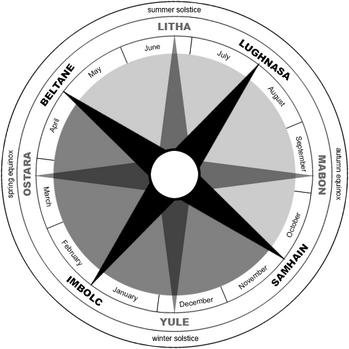
Back Sabat (wicca) Czech Rhod y Flwyddyn Welsh Wicca-Jahreskreis German Τροχός του Έτους Greek Rueda del Año Spanish چرخ سال Persian Vuodenpyörä Finnish Roue de l'année French Roda do Ano Galician גלגל השנה HE

| Part of a series on |
| Wicca |
|---|
 |
The Wheel of the Year is an annual cycle of seasonal festivals, observed by a range of modern pagans, marking the year's chief solar events (solstices and equinoxes) and the midpoints between them. Modern pagan observances are based to varying degrees on folk traditions, regardless of the historical practices of world civilizations.[1] British neopagans popularized the Wheel of the Year in the mid-20th century,[2] combining the four solar events ("quarter days") marked by many European peoples, with the four midpoint festivals ("cross-quarter days") celebrated by Insular Celtic peoples.[3]
Different paths of modern Paganism may vary regarding the precise timing of each observance, based on such distinctions as the lunar phase and geographic hemisphere. Some Wiccans use the term sabbat (/ˈsæbət/) to refer to each festival, represented as a spoke in the Wheel.[4]
- ^ Harvey, Graham (1994). "The Roots of Pagan Ecology". Journal of Contemporary Religion. 9 (3): 38–41. doi:10.1080/13537909408580720.
- ^ "Druidcast Episode 1". druidcast.libsyn.com (Podcast). 1 June 2007. Retrieved 22 June 2024.
- ^ Williams, Liz (29 July 2013). "Paganism, part 3: the Wheel of the Year". The Guardian. Retrieved 23 October 2021.
- ^ Gardner, Gerald (1954). Witchcraft Today. p. 147.